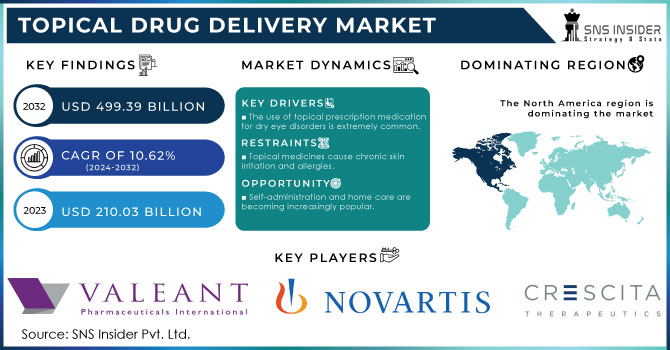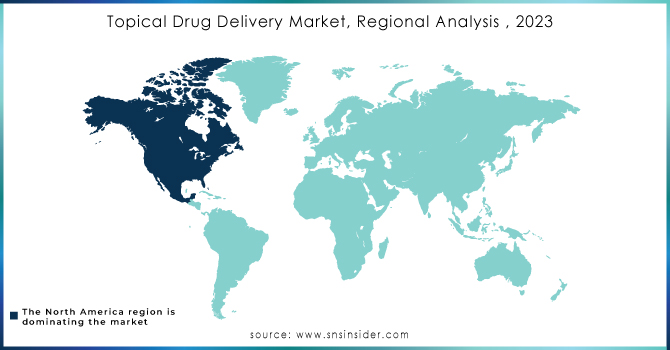Topical Drug Delivery Market Report Scope & Overview:

Get more information on Topical Drug Delivery Market - Request Sample Report
The Topical Drug Delivery Market Size was valued at USD 210.03 Billion in 2023 and is expected to reach USD 499.39 Billion by 2032 and grow at a CAGR of 10.62% over the forecast period 2024-2032.
The distribution of medications through topical routes such as the skin, mucosa, or cavities in the body is referred to as topical drug delivery. These are used locally to avoid the drug's first-pass effect or for site-specific activity. Creams, foams, lotions, gels, ointments, and other drugs are included.
A topical mode of delivery provides advantages such as site-specificity, elimination of variations in drug levels, greater suitability for self-medication, and improved compliance. The pharmacological response of a drug, both the desired therapeutic effect and the undesirable adverse consequence, is determined by the concentration of the drug at the site of action, which is determined by the dose form and the amount of drug absorption at the site of action.
MARKET DYNAMICS:
KEY DRIVERS:
-
The use of topical prescription medication for dry eye disorders is extremely common.
-
Transdermal patches are replacing traditional needle injections.
RESTRAINTS:
-
Topical medicines cause chronic skin irritation and allergies.
-
Preference for alternate drug delivery methods
OPPORTUNITY:
-
Self-administration and home care are becoming increasingly popular.
-
Biologics are delivered transdermally and Cosmetic industry uses topical vehicles
CHALLENGES:
-
Topical preparations for medicines with low plasma concentrations
-
The incidence of medicine failures and product recalls is increasing.
IMPACT OF COVID-19:
During the COVID-19 pandemic wave, self-medication was a frequent tendency for drug consumption. Many treatment facilities and single doctor clinics were closed as a result of the epidemic, depriving the general public of timely medical aid. The pandemic has prompted people to self-medicate. The most often utilised therapeutic techniques for self-medication were topical corticosteroids. Anti-acne preparations, corticosteroids, combos (corticosteroids, antibiotics, and antifungals), moisturisers, and barrier creams were the most commonly utilised topical medications. Self-medication has increased demand for over-the-counter and topical medications, which has benefited the topical drug delivery business.
One of the most common symptoms of COVID-19 was a runny nose, cold, and cough. Nasal sprays were beneficial in relieving nasal congestion during COVID-19. Amcyte Pharma, for example, introduced its Nasitrol nasal spray (topical solution) for sinus irrigation. The nasal cavity and rhino pharynx were the primary sites of SARS-CoV-2 propagation. The spray is designed to lower viral load in the upper respiratory tract, stopping viruses from multiplying and migrating into the lungs. This increase in nasal sprays that can decrease viral load during COVID-19 has raised demand for topical sprays and foams used to treat virus-induced nasal congestion.
The topical medication delivery market is divided into semi-solid formulations, liquid formulations, solid formulations, and transdermal products based on product. The semi-solid formulations segment held the greatest market share in 2021. This segment's substantial share is related to the applicability of APIs with low density, which are more stable in atmospheric conditions than liquid and solid forms, and the rise in personalised medicine due to their unique composition and increased absorptive capabilities. These dose forms are not dehydrating and have no effect on skin function.
The market is divided into five sections based on the method of administration: cutaneous, ophthalmic, rectal, vaginal, and nasal drug delivery. The dermal drug delivery market segment's large share can be attributed largely to pain-free self-administration for patients, which is advantageous for drugs with shorter half-lives or narrow therapeutic indices, as well as the elimination of frequent administration of drugs and plasma level peaks and valleys associated with oral dosing and injections to maintain a constant drug concentration.
The market is divided into home care settings, hospitals & clinics, burn centres, and other facilities based on the facility of usage. The high proportion of home care settings can be ascribed to benefits for long-term therapy, greater convenience over inpatient care, and improvements in medical adherence and treatment outcomes. Other key factors impacting the growth of the home care settings sector are the world's growing geriatric population and the growing requirement for self-administration of pharmaceuticals.
KEY MARKET SEGMENTS:
by Product
-
Semi-Solid Formulations
-
Liquid Formulations
-
Solid Formulations
-
Transdermal Products
by Route of Administration
-
Dermal Drug Delivery
-
Ophthalmic Drug Delivery
-
Rectal Drug Delivery
-
Vaginal Drug Delivery
-
Nasal Drug Delivery
by Facility of Use
-
Home Care Settings
-
Hospitals & Clinics
-
Burn Centers
-
Other Facilities
REGIONAL ANALYSIS:
North America led the topical drug delivery market, followed by Europe, Asia Pacific, Latin America, and the Middle East and Africa. The rising prevalence of target health conditions, the increasing preference for pain-free drug delivery solutions, the rising prevalence of skin diseases, an increasing number of smokers worldwide, rising advancements in transdermal patches, and the high demand for drugs that can be self-administered all contribute to North America's large share.

Need any customization research on Topical Drug Delivery Market - Enquiry Now
REGIONAL COVERAGE:
-
North America
-
USA
-
Canada
-
Mexico
-
-
Europe
-
Germany
-
UK
-
France
-
Italy
-
Spain
-
The Netherlands
-
Rest of Europe
-
-
Asia-Pacific
-
Japan
-
south Korea
-
China
-
India
-
Australia
-
Rest of Asia-Pacific
-
-
The Middle East & Africa
-
Israel
-
UAE
-
South Africa
-
Rest of Middle East & Africa
-
-
Latin America
-
Brazil
-
Argentina
-
Rest of Latin America
-
KEY PLAYERS:
The Major players are Valeant Pharmaceuticals International, Inc., Crescita Therapeutics Inc., MedPharm Group Ltd., 3M Company, Bayer AG, Novartis AG, Janssen Global Services, LLC, and Cipla, Galderma S.A., GlaxoSmithKline plc. and other players.
| Report Attributes | Details |
|---|---|
| Market Size in 2023 | US$ 210.03 Billion |
| Market Size by 2032 | US$ 499.39 Billion |
| CAGR | CAGR of 10.62% From 2023 to 2030 |
| Base Year | 2022 |
| Forecast Period | 2023-2030 |
| Historical Data | 2020-2021 |
| Report Scope & Coverage | Market Size, Segments Analysis, Competitive Landscape, Regional Analysis, DROC & SWOT Analysis, Forecast Outlook |
| Key Segments | • by Facility of Use (Homecare setting, Hospitals, Burn Centres) • by Solids(Suppositories) • by Liquids(Solutions), Transdermal products) • by Route(Dermal, Ophthalmic) • by Type (Semi-solids (Creams, Gels, Lotions) |
| Regional Analysis/Coverage | North America (USA, Canada, Mexico), Europe (Germany, UK, France, Italy, Spain, Netherlands, Rest of Europe), Asia-Pacific (Japan, South Korea, China, India, Australia, Rest of Asia-Pacific), The Middle East & Africa (Israel, UAE, South Africa, Rest of Middle East & Africa), Latin America (Brazil, Argentina, Rest of Latin America) |
| Company Profiles | Valeant Pharmaceuticals International, Inc., Crescita Therapeutics Inc., MedPharm Group Ltd., 3M Company, Bayer AG, Novartis AG, Janssen Global Services, LLC, and Cipla, Galderma S.A., GlaxoSmithKline plc. |
| Key Drivers | • Transdermal patches are replacing traditional needle injections. |
| RESTRAINTS | • Topical medicines cause chronic skin irritation and allergies. • Preference for alternate drug delivery methods. |

